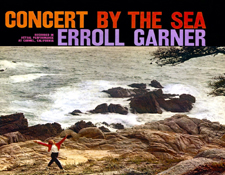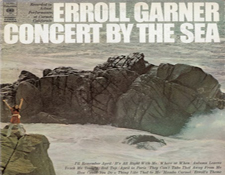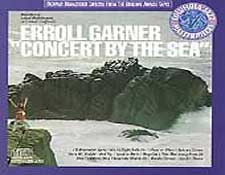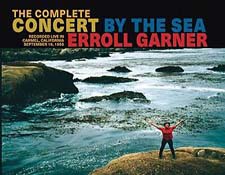It’s the time of year for saving money!
Chances are you have seen this somewhat iconic album before, either at your parent’s or grandparents house or at a flea market or thrift shop or record store bargain bin. It’s cover features graphic design so counter-intuitive to what turns out to be one of the biggest selling jazz albums in history; it looks more like a teen pop record on the outside, not a smokin’ jazz trio.

Yet, here I find myself exploring — and being a bit blown away by — Erroll Garner’s Compete Concert By The Sea on an HDTracks 192 kHz, 24-bit download and a new deluxe three CD package.
Why?
Well, in the first place, after years of seeing Mr. Garner’s albums out in the wilds of record collecting land, I picked up several of his recordings along the way out of curiosity and most left me flat. Not sure if it was bad production choices or simple lack of control over his career, but most of the music I heard by him sounded like the sort of sappy, lazy lounge piano I’d expect to hear on a late period Ferrante & Teicher album. Thus I never even considered checking out the Concert by the Sea because, well, it looked like the epitome of that sort of saccharine faux-jazz that infiltrated living rooms by the late ’50s while the real jazz stars were starving and being forced to move to Europe to sustain a career….
Boy was I wrong! You really can’t judge a book — or album, or an artist — by its cover!
Errol Garner’s Concert by the Sea is a heartfelt gem of top notch, swinging jazz piano music that — if one didn’t know better — might be mistaken for an Oscar Peterson performance. The guy was that good! I wouldn’t be surprised if he was an influence on Peterson. In fact, there are a lot of moments on here that remind me of Peterson’s run at The London House in Chicago (circa 1964), sizzling performances spread across several albums on Verve Records and eventually compiled in a wonderful deluxe set.
Now, if I was alone in this perception that Concert by the Sea as mainstream fluff, I’d feel exceptionally dumb. However, clearly, others felt this way, which eventually compelled Columbia records to reissue the album in 1970 — in electronically re-channeled (faux) stereo — with revised “hipper” cover art. On the original 1956-issued album, the cover featured a happy-go-lucky Blonde waving her arms walking (apparently) on the rocks of scenic Carmel by the Sea. On the 1970 reissue, new photography depicted a cooler, hippie-styled (but still White/Blonde) woman with then in vogue long hair and bell bottoms. This was supported by an ad campaign (reproduced in the booklet for the new reissue) bearing the headline “There was a time when you were probably too hip to bother with Erroll Garner’s Concert By The Sea.”
For this new 2015 edition, the cover has once again been recreated and more appropriately updated, this time with a beautiful and jubilant African-American woman, a step in the right direction since Mr. Garner himself was Black. It is a significant change worth noting; thank goodness the times they have been a changin’! In a perfect world it really should have been Mr. Garner down there on the rocks in Carmel waving his hands in the air!
 Today, Concert by the Sea has been given a perhaps final facelift for the ages thanks to Jamie Howarth and his Plangent Proceesses audio restoration technologies. We here at Audiophilereview have written about Mr. Howarth’s technology quite a bit previously so if you want to learn more about it, do click this link for a more in-depth look at the Plangent process, written by our editor Steven Stone.
Today, Concert by the Sea has been given a perhaps final facelift for the ages thanks to Jamie Howarth and his Plangent Proceesses audio restoration technologies. We here at Audiophilereview have written about Mr. Howarth’s technology quite a bit previously so if you want to learn more about it, do click this link for a more in-depth look at the Plangent process, written by our editor Steven Stone.
In short, Mr. Howarth’s proven proprietary technology helps correct many recording errors inherent in the tape recording process, from wow and flutter to stretched magnetic tape. Recordings out now by the likes of Bruce Springsteen and The Grateful Dead have demonstrated the remarkable reparative qualities that Plangent Processes can deliver in the form of steadier playback, more accurate reproduction of instruments, reduced noise, improved frequency response and even an enhanced sense of room and stage dynamics.
To further appreciate how good this recording now sounds, its important to briefly set the way-back machine to September 19th, 1955, when this concert was first recorded. Amazingly, the concert was not intended to have been recorded or released! But, as fate would have it, a representative from the Armed Forces Radio Service was discovered recording the show backstage. After the stellar performance, Mr. Garner’s management heard the tapes and ultimately convinced Columbia Records (a label now owned by Sony) to release the concert as a single, heavily condensed LP. History was made as one of the best selling jazz albums of all time was born, going on to sell some 225,000 copies in its first year alone — pulling in about $1 million in sales by 1958. Talk about a cash cow!
]]>Compared to the original LP — or even the digital remastered album from the 1980s — this new edition is literally like hearing this recording for the first time. Gone is the boxy compression on the original album. Gone are dropouts and tape speed fluctuations. Now we hear what a good recording this actually was, even given the less than ideal recording conditions. There is a wonderful natural balance between the band’s instrumentation and the audience. The recordist was strategically positioned to capture more of the piano in the recording — a wise choice since the piano is the star in this show! — and the bass and drums are further back in the soundstage. On this new recording you can hear Garner’s grunts and groans as he improvises, nuances all but lost on the original LPs.
 The monaural sound is full, round and punchy on the new HD Tracks download, with very natural piano tonality and remarkably clear drums. There are points on “Sweet and Lovely” where you can hear the sweep of drummer Denzil Best’s brushes as he coaxes gentle rhythms from the snare drum. I can hear the resonance of the band grooving on the wooden floors of the then-named Sunset School (now Sunset Arts Center) in Carmel by the Sea in California, where this was recorded — its hard to describe, but you can almost feel the band swing and sway, perhaps by the occasional creaking of the wooden stage.
The monaural sound is full, round and punchy on the new HD Tracks download, with very natural piano tonality and remarkably clear drums. There are points on “Sweet and Lovely” where you can hear the sweep of drummer Denzil Best’s brushes as he coaxes gentle rhythms from the snare drum. I can hear the resonance of the band grooving on the wooden floors of the then-named Sunset School (now Sunset Arts Center) in Carmel by the Sea in California, where this was recorded — its hard to describe, but you can almost feel the band swing and sway, perhaps by the occasional creaking of the wooden stage.
At the very beginning of the 1955 LP (as well as on the 1980s digital remastered LP) on “I’ll Remember April ” there is a quite noticeable drop out type event that happens just after the audience finishes applauding and Garner is comping out the rhythmic intro to the song. On the new restored version that anomaly is gone — and this is on both the “edited” original version as well the new “complete” concert (both versions are included in the download and in the three CD deluxe set).
Speaking of the CDs, some of you may be wondering how they sound? In short: real good! Curiously, the resultant compression from chopping down a high resolution file to the 16-bit, 44.1 kHz “Red Book” CD standard loosely approximates the sound one would hear if you played an original LP pressing as I have been doing. Since Concert by the Sea was a recording made in 1955, and audiophile grade gear wasn’t exactly a common thing at that time, there is no doubt in my mind (and thus this is a big guess, folks!) that a fair amount of compression was employed in the original LP mastering stage to keep the average listener’s stylus from jumping out of the grooves.
 The CD version of the complete unedited concert sounds better than the edited version (included in the set) — remember, back then to do an “edited” version, a copy of the master tape would have to have been made, creating a new master that is at least one generation down from the original. With each generation of analog dubbing came increased distortion, hiss and other gremlins that may have snuck into the process (such as tape speed variances, voltage inconsistencies, etc.).
The CD version of the complete unedited concert sounds better than the edited version (included in the set) — remember, back then to do an “edited” version, a copy of the master tape would have to have been made, creating a new master that is at least one generation down from the original. With each generation of analog dubbing came increased distortion, hiss and other gremlins that may have snuck into the process (such as tape speed variances, voltage inconsistencies, etc.).
That said, the 192 kHz / 24-bit HD Tracks version is probably as close as any of us will get to hearing the first generation master tape in all its monophonic and unfettered glory. Plangent Processes lets the music come back together the way it was meant to be heard.
There is no contest between the old LP versions and the new HD Tracks remaster. So if you want a really fine version of this recording, do pick that up. The new CD set is probably your next best bet. I do not know if there is an LP counterpart to this reissue series.
That said, it probably makes good sense for you interested vinyl junkies out there to go pick up a copy of the original vinyl version on your next crate digging excursion, just so you have something to compare and contrast (as I did!). Next to Herb Alpert’s Whipped Cream & Other Delights album, Erroll Garner’s Concert By The Sea is arguably one of the most common albums to find in used record stores, thrift shops, flea markets and garage sales. Look carefully however — finding a clean original copy isn’t necessarily that easy, but if I am any sort of example, I located a pretty nice one in preparation for this review with a minimum of effort just from poking around a few shops here in San Francisco.
Either way, get this album and be prepared to be surprised. If you like piano based jazz, this is fine fine stuff that will sit neatly next to your classics by Oscar Peterson, Vince Guaraldi and even Bill Evans. Pure swingin’ jazz piano played live without a net, now sounding better than ever.






